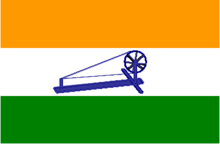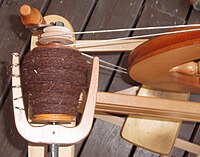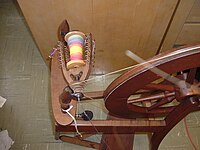Spinning wheel: Difference between revisions
No edit summary |
|||
| Line 4: | Line 4: | ||
==History== |
==History== |
||
''Technology in World Civilization'' ([[MIT]] Press) |
In 1991, ''Technology in World Civilization'' ([[MIT]] Press) surveyed the origins of the spinning wheel:<ref>{{cite book | last = Pacey | first = Arnold | title = Technology in World Civilization: A Thousand-Year History | origyear = 1990 | edition = First MIT Press paperback edition | year = 1991 | publisher = The MIT Press | location = Cambridge MA}}</ref> <blockquote>One controversial aspect of the history of technology in [[North India]] concerns spinning wheel. Because cotton textiles originated in India, it has long been assumed that the spiniing wheel, as used with cotton, must also have been invented in the subcontinent, perhaps between AD 500 and 1000. However, early references to cotton spinning are so vague that none clearly identifies a wheel, according to [[Irfan Habib]]. The references could equally indicate earlier methods of hand-spinning. The earliest unambiguous reference is in a document dating from about 1350 which mentions women using spinning wheels in the previous century. Habib also points out that the most usual word in India for a spinning wheel is ''charkha'', and this derives from the [[Persian language]]. He therefore thinks that the spinning wheel was introduced into India from Iran in the thirteenth century.</blockquote> |
||
According to the ''Britannica Concise Encyclopedia'' (2007): "The spinning wheel was probably invented in India, though its origins are unclear."<ref>"spinning wheel" in Britannica Concise Encyclopedia (2007). 1994-2008 Encyclopedia Britannica, Inc.</ref> [[MSN Encarta]] (2007) further adds: "The spinning wheel, introduced into [[Europe]] from India between the 13th and 14th centuries, improved the hand-spinning method. The spindle was set horizontally in a wheel turned by a foot pedal and produced a single thread. Spinning by hand is still the principal method used in many developing countries."<ref>"Spinning," Microsoft® Encarta® Online Encyclopedia 2007 |
|||
<blockquote>It has long been assumed that the spinning wheel, as used with cotton, must have been invented in the subcontinent, perhaps between AD 500 and 1000. However, early references to cotton spinning are so vague that none clearly identifies a wheel, according to Irfan Habib. The references could equally indicate earlier methods of hand-spinning. The earliest unambiguous reference is in a document dating from about 1350 which mentions women using spinning wheels in the previous century. Habib also points out that the most usual word in India for a spinning wheel is ''charkha'', and this derives from the Persian language. He therefore thinks that the spinning wheel was introduced into India from Iran in the thirteenth century.</blockquote> |
|||
http://encarta.msn.com © 1997-2007 Microsoft Corporation. All Rights Reserved.</ref> |
|||
The spinning wheel replaced the earlier method of [[hand spinning]] with a [[spindle (textiles)|spindle]]. The first stage in mechanizing the process was mounting the spindle horizontally so it could be rotated by a cord encircling a large, hand-driven wheel. The great wheel is an example of this type, where the fiber is held in the left hand and the wheel slowly turned with the right. Holding the fiber at a slight angle to the spindle produced the necessary twist.<ref>Spinning wheel. (2007). In Encyclopædia Britannica. Retrieved April 7, 2007, from Encyclopedia Britannica Online.</ref> The spun yarn was then wound onto the spindle by moving it so as to form a right angle with the spindle. This type of wheel, while known in Europe by the 14th century, was not in general use until later. It ultimately was used there to spin a variety of yarns until the beginning of the 19th century and the mechanization of spinning. |
|||
[[Image:Woodcut Woman Spinning Detail.jpg|left|thumb|150px|Woman spinning with a wheel, early 17th century.]] |
[[Image:Woodcut Woman Spinning Detail.jpg|left|thumb|150px|Woman spinning with a wheel, early 17th century.]] |
||
In general, the spinning technology was known for a long time before being adopted by the majority of people thus making it hard to fix dates of the improvements. In 1533, a citizen of Brunswick is said to have added a treadle, by which the spinner could rotate her spindle with one foot and have both hands free to spin. [[Leonardo da Vinci]] drew a picture of the flyer, which twists the yarn before winding it onto the spindle. During the [[16th century]] a treadle wheel with flyer was in common use, and gained such names as the Saxony wheel, and the flax wheel. It sped up production as one needn't stop spinning to wind up the yarn. |
In general, the spinning technology was known for a long time before being adopted by the majority of people thus making it hard to fix dates of the improvements. In 1533, a citizen of Brunswick is said to have added a treadle, by which the spinner could rotate her spindle with one foot and have both hands free to spin. [[Leonardo da Vinci]] drew a picture of the flyer, which twists the yarn before winding it onto the spindle. During the [[16th century]] a treadle wheel with flyer was in common use, and gained such names as the Saxony wheel, and the flax wheel. It sped up production as one needn't stop spinning to wind up the yarn. |
||
Revision as of 04:42, 18 April 2008

Library of Congress collection

A spinning wheel is a device for spinning thread or yarn from natural or man-made fibers.
History
In 1991, Technology in World Civilization (MIT Press) surveyed the origins of the spinning wheel:[1]
One controversial aspect of the history of technology in North India concerns spinning wheel. Because cotton textiles originated in India, it has long been assumed that the spiniing wheel, as used with cotton, must also have been invented in the subcontinent, perhaps between AD 500 and 1000. However, early references to cotton spinning are so vague that none clearly identifies a wheel, according to Irfan Habib. The references could equally indicate earlier methods of hand-spinning. The earliest unambiguous reference is in a document dating from about 1350 which mentions women using spinning wheels in the previous century. Habib also points out that the most usual word in India for a spinning wheel is charkha, and this derives from the Persian language. He therefore thinks that the spinning wheel was introduced into India from Iran in the thirteenth century.
According to the Britannica Concise Encyclopedia (2007): "The spinning wheel was probably invented in India, though its origins are unclear."[2] MSN Encarta (2007) further adds: "The spinning wheel, introduced into Europe from India between the 13th and 14th centuries, improved the hand-spinning method. The spindle was set horizontally in a wheel turned by a foot pedal and produced a single thread. Spinning by hand is still the principal method used in many developing countries."[3]
The spinning wheel replaced the earlier method of hand spinning with a spindle. The first stage in mechanizing the process was mounting the spindle horizontally so it could be rotated by a cord encircling a large, hand-driven wheel. The great wheel is an example of this type, where the fiber is held in the left hand and the wheel slowly turned with the right. Holding the fiber at a slight angle to the spindle produced the necessary twist.[4] The spun yarn was then wound onto the spindle by moving it so as to form a right angle with the spindle. This type of wheel, while known in Europe by the 14th century, was not in general use until later. It ultimately was used there to spin a variety of yarns until the beginning of the 19th century and the mechanization of spinning.

In general, the spinning technology was known for a long time before being adopted by the majority of people thus making it hard to fix dates of the improvements. In 1533, a citizen of Brunswick is said to have added a treadle, by which the spinner could rotate her spindle with one foot and have both hands free to spin. Leonardo da Vinci drew a picture of the flyer, which twists the yarn before winding it onto the spindle. During the 16th century a treadle wheel with flyer was in common use, and gained such names as the Saxony wheel, and the flax wheel. It sped up production as one needn't stop spinning to wind up the yarn.
In the 18th century the Industrial Revolution had a big effect on the spinning industry by beginning to mechanize the spinning wheel. Lewis Paul and John Wyatt first worked on the problem in 1738, patenting the Roller Spinning machine and the flyer-and-bobbin system, for drawing wool to a more even thickness. Using two sets of rollers that traveled at different speeds yarn could be twisted and spun quickly and efficiently. They however did not have much financial success, nor did Thomas Highs, credited as the inventor of the spinning jenny. In 1771, Richard Arkwright used waterwheels to power looms for the production of cotton cloth, his invention becoming known as the water frame.
These improvements continued and culminated in the first rotor or open end spinning mills in the United States in the 1780's and 1790's. More modern spinning machines use a mechanical means to rotate the spindle, as well as an automatic method to draw out fibers, and devices to work many spindles together at speeds previously unattainable.[5] Newer technologies that offer even faster yarn production include friction spinning, an open-end system, and air jets.[6]
Types of spinning wheels

Numerous types of spinning wheels exist, including the great wheel also known as walking wheel or wool wheel for rapid long draw spinning of woolen-spun yarns; the flax wheel, which is a double-drive wheel used with a distaff for spinning linen; saxony and upright wheels, all-purpose treadle driven wheels used to spin worsted-spun yarns; and the charkha, native to Asia. Until the acceptance of rotor spinning wheel, all yarns were produced by aligning fibers through drawing techniques and then twisting the fiber together. With rotor spinning, the fibers in the roving are separated, thus open end, and then wrapped and twisted as the yarn is drawn out of the rotor cup.
Hand-powered wheels
Hand powered spinning wheels are powered by the spinner turning a crank for flywheel with their hand, as opposed to pressing peddles or using a mechanical engine.
Charkha


The tabletop or floor charkha is one of the oldest known forms of the spinning wheel. The charkha works similarly to the great wheel, with a drive wheel being turned by hand, while the yarn is spun off the tip of the spindle.The floor charkha and the great wheel closely resemble each other. With both, the spinning must stop in order to wind the yarn onto the spindle.[citation needed]
The charkha (etymologically related to Chakra) was both a tool and a symbol of the Indian independence movement.The charkha, a small, portable, hand-cranked wheel is ideal for spinning cotton and other fine, short-staple fibers, though it can be used to spin other fibers as well. The size varies, from that of a hardbound novel to the size of a briefcase, to a floor charkha. Mahatma Gandhi brought the charkha into larger use with his teachings. He hoped the charkha would assist the peoples of India achieve self-sufficiency and independence, and so used the charkha as a symbol of the Indian independence movement and included it on earlier versions of the Flag of India. [citation needed]
Great wheel
The great wheel was one of the earlier types of spinning wheel. The fiber is held in the left hand and the wheel slowly turned with the right. This wheel is thus good for using the long-draw spinning technique, which requires only one active hand most of the time, thus freeing a hand to turn the wheel. The great wheel is usually used to spin wool, and can only be used with fiber preparations that are suited to long-draw spinning.

The great wheel is usually over 5 feet in height. The large drive wheel turns the much smaller spindle assembly, with the spindle revolving many times for each turn of the drive wheel. The yarn is spun at an angle off the tip of the spindle, and is then stored on the spindle. To begin spinning on a great wheel, first a leader (a length of waste yarn) is tied onto the base of the spindle and spiraled up to the tip. Then the spinner overlaps a handful of fiber with the leader, holding both gently together with the left hand, and begins to slowly turn the drive wheel clockwise with the right hand, while simultaneously walking backward and drawing the fiber in the left hand away from the spindle at an angle. The left hand must control the tension on the wool to produce an even result. Once a sufficient amount of yarn has been made, the spinner turns the wheel backward a short distance to unwind the spiral on the spindle, then turns it clockwise again, and winds the newly made yarn onto the spindle, finishing the wind-on by spiraling back out to the tip again to make another draw.
Treadle wheel
This type of wheel is powered by the spinner's foot rather than their hand or a motor. The spinner sits and pumps a foot treadle that turns the drive wheel via a crankshaft and a connecting rod. This leaves both hands free for drafting the fibers, which is necessary in the short draw spinning technique, which is often used on this type of wheel. The old-fashioned pointed distaff spindle is not a common feature of the treadle wheel. Instead, most modern wheels employ a flyer-and-bobbin system which twists the yarn and winds it onto a spool simultaneously. These wheels can be single- or double-treadle; which is a matter of preference and does not affect the operation of the wheel.

Double drive
The double drive wheel is named after its drive band, which goes around the spinning wheel twice. The drive band turns the flyer, which is the horse-shoe shaped piece of wood surrounding the bobbin, as well as the bobbin. Due to a difference in the size of the whorl (or the round piece around which the drive band runs) the bobbin whorl, which has a smaller radius than the flyer whorl, turns faster. This difference in speed winds the yarn onto the bobbin. Generally the speed difference or "ratio" is adjusted by the size of the whorls and the tension of the drive band.
The drive band on the double drive wheel is generally made from a no-stretch yarn or twine; candlewick is also used.
Single drive

A single drive wheel has one drive band, that goes around the fly-wheel and the bobbin or the flyer. Most of the drive bands for single drive wheels are made from synthetic cord, which is elastic and does not slip easily on the wheel.
While the spinner is making new yarn, the bobbin and the flyer turn in unison, but when the spinner wants to wind the yarn onto the bobbin, the bobbin or the flyer slows down and thus the yarn winds on. The one part slows down because of the brake band, which loops over that element. The tighter the brake band is, the more pull on the yarn, because the more friction the bobbin has to overcome in order to turn in sync with the flyer.
Castle style

When the spindle and flyer are located above the wheel, rather than off to one side, the wheel is said to be a castle wheel. This type of wheel is often more compact, thus easier to store. Some castle wheels are even made to fold up small enough that they fit in carry-on luggage at the airport.
Notes
- ^ Pacey, Arnold (1991) [1990]. Technology in World Civilization: A Thousand-Year History (First MIT Press paperback edition ed.). Cambridge MA: The MIT Press.
{{cite book}}:|edition=has extra text (help) - ^ "spinning wheel" in Britannica Concise Encyclopedia (2007). 1994-2008 Encyclopedia Britannica, Inc.
- ^ "Spinning," Microsoft® Encarta® Online Encyclopedia 2007 http://encarta.msn.com © 1997-2007 Microsoft Corporation. All Rights Reserved.
- ^ Spinning wheel. (2007). In Encyclopædia Britannica. Retrieved April 7, 2007, from Encyclopedia Britannica Online.
- ^ Encyclopedia Britannica Eleventh Edition article on spinning.
- ^ Cotton: Origin, History, Technology, and Production By C. Wayne Smith, Joe Tom Cothren. Page viii. Published 1999. John Wiley and Sons. Technology & Industrial Arts. 864 pages. ISBN 0471180459
See also
External links
- The Spinning Wheel by Mary Bellis
- Yarn at enotes.com
- Spinning Cotton - with charkha diagram


